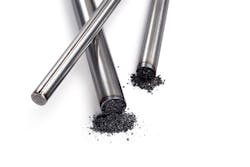Options for Automating Molten-Metal Treatment
Q: Our foundry is considering modernizing through automation of certain processes. What are our options for magnesium treatment, alloying, and inoculation?
A: Let us address these options in reverse order. A very common method of auto-inoculation is via the in-stream method, wherein very fine-grained material stored in a hopper is precisely dosed and expelled from a guide tube slightly pressurized with air. Dispersed inoculant then joins the molten metal stream just before entering the mold. The obvious advantage here is the very late inoculation step, taking fading concerns out of question. In-stream units can be self-calibrating, pre-programmed for different jobs, and also integrated with cameras and molding lines to export historical inoculation records for each individual mold into a database.
Auto-alloying stations are common for FeSiMg and other alloying additions, in combination with this inoculation method. An array of hoppers dispense alloys onto a weighing conveyor belt, which delivers the alloys to the bottom of an empty ladle. This is most common with traditional pour-over, or sandwich open-ladle practices (typically 1.2-1.8% addition rate.) The main benefit is the time (i.e., treatment starts during the tapping), with minimal adjustments / changes needed to existing open ladle practice.
Cored wire consists of hollowed steel wire packed with fine-grained material. Cored-wire filler may be either pure Mg, Mg alloy, FeSiMg alloy, FeSi-based inoculant, FeSiMg pure La, or any blend of these options. Using wire feeder / injector, the wire (single or multiple feeds) is fed to the bottom of the ladle filled with molten metal, or into a molten metal stream/pouring unit. The main advantage here is that you always know exactly the treatment size and composition. And, with this method you achieve unparalleled flexibility with regard to fluctuating initial iron conditions and, thus, consistency in final iron can be achieved. Cored-wire Mg-treatment process also can handle desulfurization and Mg-treatment in a single step in cupola-produced ductile iron.
What factors should we consider to decide between different automated processes? Not every foundry operates under the same conditions with the same priorities. Each situation should be addressed properly on an individual basis. Based on the evolution of Mg-treatment methods, technological innovations in the industry, tightening environmental regulations, and ongoing automation in manufacturing, we recommend the cored-wire process:
• The cored-wire process can be fully automated, where dosing is computed on the fly by integrating wire injectors with other data units, like thermal curve analysis software. This compensates for fluctuations in temperature, weight, and chemical composition yielding unparalleled consistency in final iron.
Furthermore, cored-wire stations may contain more than one wire. Wires could be of the same type to speed up delivery process, or could be completely different (e.g., desulfurization, magnesium treatment, inoculation all done automatically in one location.)
• Cored-wire technology delivers alloys to the bottom of a ladle before it reacts with the metal. This maximizes the time reagents are exposed to molten metal, as they float to the surface. This effect is further enhanced by fine-grained material, which dissolves very rapidly, so reaction takes place well before material reaches the atmospheric interface, unlike open-ladle methods where it is almost impossible to delay the reaction until the ladle is completely full. This increases the efficiency of the reaction, with economic benefits.
• Like in-stream inoculation, inoculation with cored wire delivers fine material, assuring fast dissolution times. However, inoculation with cored wire is 100% efficient as it does not incur loss due to some powder not reaching the metal and some portion of inoculant getting oxidized at the surface, as with the in-stream method.
• Cored wire’s precise dosing and tight residual magnesium range is ideal for producing compacted graphite iron, with addition of inoculation wire to the wire station.
• Cored wire has one of the lowest addition rates, which reduces slag formation and temperature loss during the Mg-treatment. Typically, we see 0.8-1.0% addition rate of FeSiMg (standard main influencing factors of Mg-treatment still apply.)
• Cored wire can address sulfur contents well above 0.02% for ductile iron treatment.
• Cored wire composition can be customized to customers’ specific needs. ASK Chemicals has designed over 700 different cored-wire formulations, ranging from pure magnesium wire to various blends of FeSi-based alloys for inoculation or magnesium treatment.
• Encapsulated alloys are wrapped in steel sheet, protected from atmosphere and oxidation, to prevent weakening of alloy potential.
• Desulfurizing wires eliminate non-reacted calcium carbide, alleviating disposal challenges/costs.
• Wire stations can be fully enclosed, to capture all reaction effluents.
Join the Conversation. Email Your Questions for ASK Chemicals
Share your insights, opinions, and elaborate on the questions and the experts' answer(s). You must be logged in to the website in order to post your comments.
